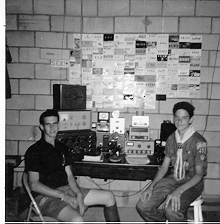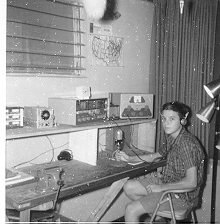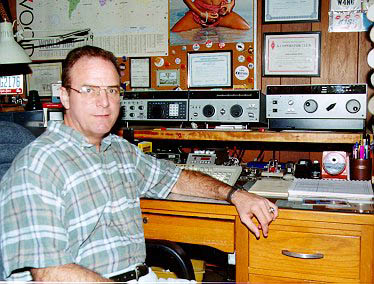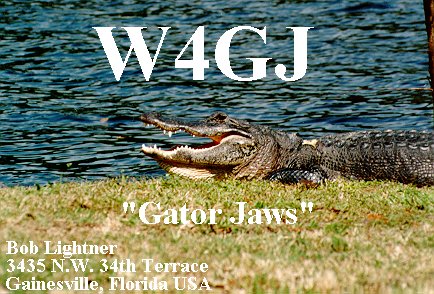Amateur Radio Station
How I got
started in the hobby of HAM Radio
I’ve been an Amateur Radio Operator since I was 13 years old. While
attending Sebring Boy Scout Camp in the summer of 1961, I was introduced
to the hobby by one of the camp counselors, Steve Fried, WA4AMC. Steve
taught Morse Code to the campers who were studying for their First Class
badge and demonstrated the hobby to the scouts via his HAM station, set
up at the camp to send radiograms home to the parents of the campers. I
was determined to get my own HAM license, so the next summer I had studied
the ARRL license manual and Steve gave me the Novice examination. I have
enjoyed this hobby ever since!
Sebring Boy Scout
Camp + My
First Station


This is a photo of me and Steve Fried at the Boy
Scout camp and my first HAM station.
ORIGIN OF THE NICK NAME OF
"HAM" RADIO
HAM Radio is an interesting nickname for people
who engage in the hobby known also as Amateur Radio. It's origin comes
from the early days of radio--before the Federal Communications Commission,
(FCC) was formed. Early radio experimenters were not licensed and had no
assigned call signs, like modern HAMS. One of the original stations operating
from Harvard, used the call letters H-A-M which stood for the first letters
of each of the surnames of the operators; Albert Hyman, Bob Almy, and Peggie
Murray. When proposed federal legislation threatened to destroy Amateur
Radio Hyman went to
Washington to testify and defend his station “HAM.” As a result the
word “HAM” came to mean a radio hobbyist, licensed by the FCC in the Amateur
Radio Service.
HAM Radio operators have developed ways to communicate not only on the
original frequencies alloted to them by the FCC but on new frequencies
acquired over the years. HAMS were prime inventors of different modes
of communcation in common use today. They continue to develop new forms
of communicating. Cellular telephones are a HAM invention, along
with many other commonly used communications devices.
Personal HAM Radio History
August 28, 1962 Novice Class license, call sign: WN4JOM
August 22, 1963 Upgraded to Technician Class and became WA4PWF
August 17, 1964 Upgraded to General Class
January 1, 1977 Upgraded to Advanced Class
October 31, 1978 Upgraded to Amateur Extra Class
On November 4, 1995 I changed my call sign to the present one, W4GJ,
which was formerly held by the late Walt Kinney of Miami. Over the years
I have taught HAM radio to others and carried on the tradition Steve taught
me way back in 1961. Some of my dearest friends I met through HAM radio
and I try to help others get into the hobby whenever I can. I have also
held Amateur Radio licenses in Germany and France. Both of these licenses
were issued as reciprocal licenses through the Deutsche Bendespost and
the Telecommunications des Reseaux Exterieurs.
I am also the trustee of Santa Fe Community College Amateur Radio Society's
[SFARS] HAM station, K4EAC.
I am the QSL manager for YS1EJ, Juan Molina
in El Salvador. For information about receiving a QSL card from JuanCHECK
HERE
Awards, Certificates, and Achievements
 DXCC-CW #2143 - QCWA
Membership #20,913 - W1AW's 40 WPM Code Proficiency Certificate
- W6OWP's 60 WPM Code Proficiency Certificate - WAC - WAS #19,100
- A1-Operator's Club - Bicentennial WAS #2735- AMSAT Member # 4476- RCC
- BPL - OES
DXCC-CW #2143 - QCWA
Membership #20,913 - W1AW's 40 WPM Code Proficiency Certificate
- W6OWP's 60 WPM Code Proficiency Certificate - WAC - WAS #19,100
- A1-Operator's Club - Bicentennial WAS #2735- AMSAT Member # 4476- RCC
- BPL - OES

Station Equipment
Ten Tec Omni VI-Plus Model 564 transceiver
Ten Tec Model 962 power supply
Ten Tec Model 238 antenna tuner
Ten Tec Model 422 "Centurion" linear amplifier
Ten Tec Model 1220 2-meter FM transceiver
Ten Tec Model 1260 6-Meter FM transceiver
Icom 471-A 430 MHz All Mode transceiver
DX4WIN logging program and keyboard
Antennas/Towers
50-foot Rohn 25G, Hazer
4, Force 12 XR-5, an 80/40 Inverted Vee
and a Diamond V200A 6M/2M/70CM Triband vertical
Rhombic Loop antenna for 160 Meters
MY [Electronic]
QSL CARD

Send me E-Mail at: w4gj@juno.com

This page last updated on November 1, 2002.
WITHOUT C.W., IT'S JUST C.B.!



 DXCC-CW #2143 - QCWA
Membership #20,913 - W1AW's 40 WPM Code Proficiency Certificate
- W6OWP's 60 WPM Code Proficiency Certificate - WAC - WAS #19,100
- A1-Operator's Club - Bicentennial WAS #2735- AMSAT Member # 4476- RCC
- BPL - OES
DXCC-CW #2143 - QCWA
Membership #20,913 - W1AW's 40 WPM Code Proficiency Certificate
- W6OWP's 60 WPM Code Proficiency Certificate - WAC - WAS #19,100
- A1-Operator's Club - Bicentennial WAS #2735- AMSAT Member # 4476- RCC
- BPL - OES


